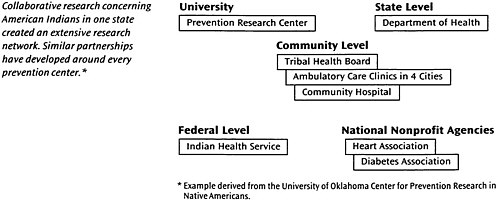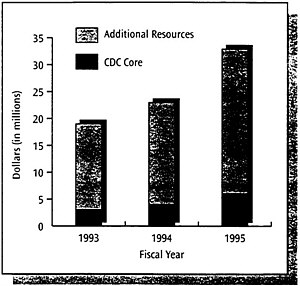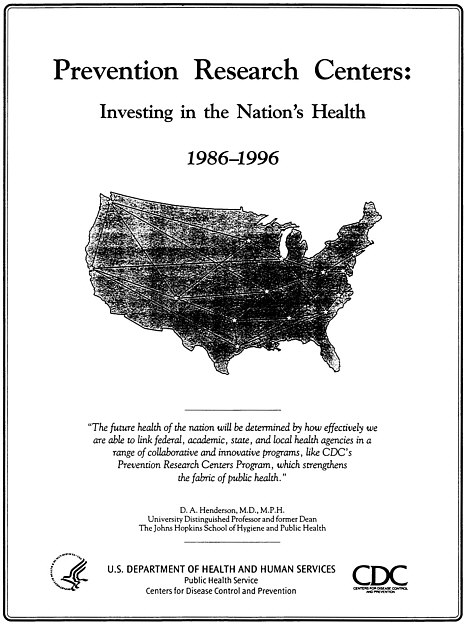National Research Network
The CDC-administered Health Promotion Disease Prevention Research Centers Program integrates the resources of 14 academic centers committed to research that benefits public health. This national network for applied research focuses on the behaviors that put Americans at risk for chronic health conditions that claim a disproportionate number of lives. The centers are particularly concerned about the quality of life for special populations (including the elderly and the underserved) and how to curb the premature morbidity and mortality that drive the nation's excessive health care costs.
The expertise of university research centers is made available to health agencies, community-based organizations, and national nonprofit organizations. This link between university research and grassroots organizations helps turn research results into practical, cost-effective, and innovative programs.
High-Priority Research Themes
In 1986, the first three centers were funded, and new centers have been continually added. Research themes have broadened to include specific conditions (such as cardiovascular disease) and the health status of children and adolescents. The network now links a set of well-respected research institutes focusing on the health conditions of diverse communities in distinct geographic areas, including Harlem, the Southwest, Appalachia, and Missouri's Bootheel.
|
Physical inactivity is a modifiable risk behavior linked to several chronic diseases. Not all assessments of physical activity among minority women have been appropriate for the specific population studied. The prevention centers at the University of South Carolina and the University of New Mexico are entering the second year of community-based research on physical activity practices among black and American Indian women aged 40 years or older. This effort is providing innovative survey instruments for asking respondents about the types of activities in which they are most likely to be involved—that is, activities integral to the daily lives of these women. |
|
Host University |
First Funded |
Research Theme |
|
University of Alabama at Birmingham |
1993 |
Risk Reduction Among African-American and Other Underserved Populations |
|
University of California at Berkeley |
1993 |
Families, Neighborhoods, and Communities: A Model for Action in Chronic Disease Prevention |
|
Columbia University |
1990 |
Reduction of Excess Morbidity and Mortality in the Harlem Community |
|
University of Illinois at Chicago |
1990 |
Health Promotion and Disease Prevention Across the Lifespan |
|
The Johns Hopkins University |
1993 |
Promoting Health and Preventing Disease Among Urban and Rural Adolescents |
|
University of Minnesota |
1996 |
Teen Pregnancy Prevention |
|
University of New Mexico |
1995 |
Promoting Healthy Lifestyles in American Indians |
|
University of North Carolina at Chapel Hill |
1986 |
Workplace Health Promotion |
|
University of Oklahoma |
1994 |
Promoting Healthy Behavior and Disease Prevention in Native American Populations |
|
Saint Louis University |
1994 |
Cardiovascular Disease Prevention in Low-Income Rural Communities |
|
University of South Carolina |
1993 |
Promoting Health Through Physical Activity |
|
University of Texas at Houston |
1986 |
From Healthy Children to Healthy Adults |
|
University of Washington at Seattle |
1986 |
Keeping Older Adults Healthy and Independent |
|
West Virginia University |
1994 |
Risk Factors in Appalachia |
Support for National Health Objectives
The prevention centers' research environment furthers four main goals that support progress in achieving national health objectives.
Maximize Resources for Complex Public Health Research
The program not only encourages extramural research in public health but creates an environment in which academic centers can communicate about and collaborate on research themes. The centers share ideas, discuss strategies, and pool talent and material resources to avoid unnecessary duplication of effort.
Each center also fosters interaction among faculty in different disciplines. Departments of education, psychology, social work, and nursing are involved with the school of public health or the preventive medicine program that oversees the prevention center. Since most health issues are complex, this blending of expertise is advantageous to finding workable solutions.
|
The Tobacco Control Network stimulates interaction among multidisciplinary staff at nearly every prevention center. The network, coordinated by the University of Illinois, collaborates with CDC's Office on Smoking and Health in selecting tobacco control research themes for the prevention centers. For example, the centers are seeking to increase understanding about adolescent smoking and the racial and geographic differences in teen smoking behavior. Researchers from behavioral science, nursing, anthropology, social work, and epidemiology are working together to find strategies that discourage tobacco use among youth. Without the structure of the prevention centers program, this multifaceted and interinstitutional interaction might not occur, and the research would be less rich. |
Make Communities Accessible and Amenable to Prevention Interventions
Long-standing relationships between the prevention centers and their immediate communities bring public health researchers closer to the public. Interventions can be introduced so that they are most effective and credible to specific populations. Multiple health risk factors can be simultaneously addressed by strategies that anticipate underlying community attitudes, beliefs, and perceptions.
|
Researchers at the University of North Carolina are surveying the health attitudes and beliefs of the black community in Durham, North Carolina, investigators are assessing the degree to which the community trusts government-sponsored biomedical research—a preliminary evaluation that could not be done by the government itself. Results from this representative community will guide federal agencies in promoting AIDS vaccine trials and other therapies in black communities throughout the United States. |
Increase Collaboration Among Agencies and Nontraditional Partners
The program allows collaboration among federal and nonfederal partners. For example, the prevention centers program is conducting the community prevention component of the National Institutes of Health's multiyear Women's Health Initiative, one of the largest U.S. prevention studies of perimenopausal and postmenopausal women.
In addition, each prevention center must conduct at least one demonstration project with a state or local health department, board of education, or community-based organization. The University of California at Berkeley, for example, has forged partnerships with managed care alliances and health maintenance organizations (HMOs). Public health departments are using information about preventive health services among private patients to design a family HMO for economically disadvantaged families.
“The leadership from The Johns Hopkins Center for Adolescent Health Promotion and Disease Prevention has been the catalyst for bringing together local organizations serving youth. The center's one-day conference, ‘Best Practices in Adolescent Health,' addressed the three issues that most threaten our young people: violence, substance abuse, and injuries. Community providers shared information about their successes. This type of networking strengthens grassroots prevention programs.”
Judith Sensenbrenner, M.D., M.P.H.
Health Officer, Wicomico County, Maryland
Train Public Health Professionals
By involving academic researchers; federal, state, and local public health workers; personnel from numerous national agencies and community-based organizations; and practitioners from hospitals and managed care environments, the prevention centers program is expanding the capacity of diverse professionals to conduct prevention research and apply its results. In addition, the Association of Schools of Public Health places graduate public health interns in the prevention centers. Thus, the centers are a continuous source of education and training for both current and future disease prevention researchers. The interns benefit from exposure to research that involves faculty from several academic departments and that tests innovative ways to approach public health issues.
|
At the University of Washington's Northwest Center for Prevention Research, the School of Public Health and Community Medicine, the School of Pharmacy, and the area's largest health maintenance organization are collaborating on a database project linking patients' pharmacologic records with patients' health status information and sociodemographic characteristics. These comprehensive patient profiles will offer researchers a unique body of data in which to test epidemiologic hypotheses. Students involved in this project are in the vanguard of the emerging partnership between the public health sector and managed care. |

Value-Added Funding of Prevention Research
Recognition that an investment in prevention can improve the quality of life and lead to savings in health care and other societal costs prompted the establishment of the prevention centers program by public law in 1984.
The core program dollars CDC provides constitute a small but critical percentage of each prevention center's overall budget. These dollars support each center's basic infrastructure—core faculty and research assistants—without which the center would not exist. Every prevention center has been able to leverage CDC dollars to garner additional outside support for health promotion research, demonstration projects, and the dissemination of findings. Thus, the prevention research capacity has expanded well beyond the basic level of program support.
For example, the University of Alabama's Center for Health Promotion increased its applied research capacity ninefold in three years. The additional prevention research resources were not forthcoming until CDC's initial investment had been made. Similarly, CDC's seed money for the University of Washington's Center for Health Promotion in Older Adults funded a study that in turn attracted an additional half-million dollars. At Columbia University, CDC core dollars funded only 3 of 15 prevention projects this year, and at the University of Texas, 4 of 29.
CDC's continued investment in the prevention centers sustains their core resources and their ability to attract support for wide-ranging prevention research. Interest has come from other agencies, foundations, and programs that want to invest in CDC-supported research institutes.

Benefits of Continuity
Sustained support ensures that research in progress remains uninterrupted and that the well-developed research network remains intact. Prevention projects can then be replicated and disseminated, prevention training for health professionals can be enhanced and diversified, and progress toward achieving national health objectives can be accelerated. Goals for the next decade of progress are designed to expand the breadth and depth of the total prevention effort.
“The arrangement affords an ideal combination of talents—a public health agency's experience in working with high-risk populations and the research skills of a health sciences center.”
Bert Malone, M.P.A.
Director, Division of Chronic Disease Prevention and Health Promotion
Missouri Department of Health
“The University of New Mexico Center for Health Promotion has helped us, as a community, maintain focus on prevention issues and total health. The direction the center provides benefits our community through our Tribal Health Department.”
Randolph Padilla
Governor, Pueblo of Jemez, New Mexico
Extending the Public Health Mission
The prevention centers' two main program goals support and enhance CDC's public health mission.
Prevention centers' goals
-
Provide a sound scientific basis for health promotion and disease prevention policies and practices.
-
Translate research findings into community-based interventions.
CDC's mission
Promote health and improve the quality of life for Americans by preventing and controlling disease, injury, and disability.
Key Accomplishments
Members of the prevention centers accomplish many prevention research goals.
-
Collaborate with academic institutions and state and local government agencies to address high-priority public health issues.
-
Reach diverse ethnic and racial communities for collecting data and transferring results.
-
Conduct demonstration and evaluation projects.
-
Disseminate the latest research results.
-
Serve as an extension of the public health effort.
-
Expand the training capacity for public health professionals.
-
Multiply the investment in prevention research by effectively using core funds to attract funding from other sources.
-
Conduct background studies and pilot projects, analyze survey data, and conduct innovative prevention research.
|
In Missouri's Bootheel, the Saint Louis University Prevention Center translates science into practice by forging coalitions that take chronic disease prevention interventions to communities. These coalitions represent a 13-county area that is medically underserved and economically disadvantaged and has the highest rates of chronic disease in the state. The center designs interventions to address the three main risk factors among people in the area: poor diet, smoking, and physical inactivity. Working through the coalitions, the center teaches school-age youth how to eat healthily, helps local officials curb tobacco sales to minors, and builds walking trails in areas where sidewalks are infeasible. These efforts are predicated on the belief that deeply ingrained habits, traditions, and cultural norms influence disease rates and that change can be achieved only by the people themselves. |
For more information, please contact:
Centers for Disease Control and Prevention
Health Promotion Disease Prevention Research Centers Program, Mail Stop K–30
4770 Buford Highway, NE
Atlanta, GA 30341-3724
Phone: (770) 488-5395
E-mail: njs0@ccdosal.em.cdc.gov








